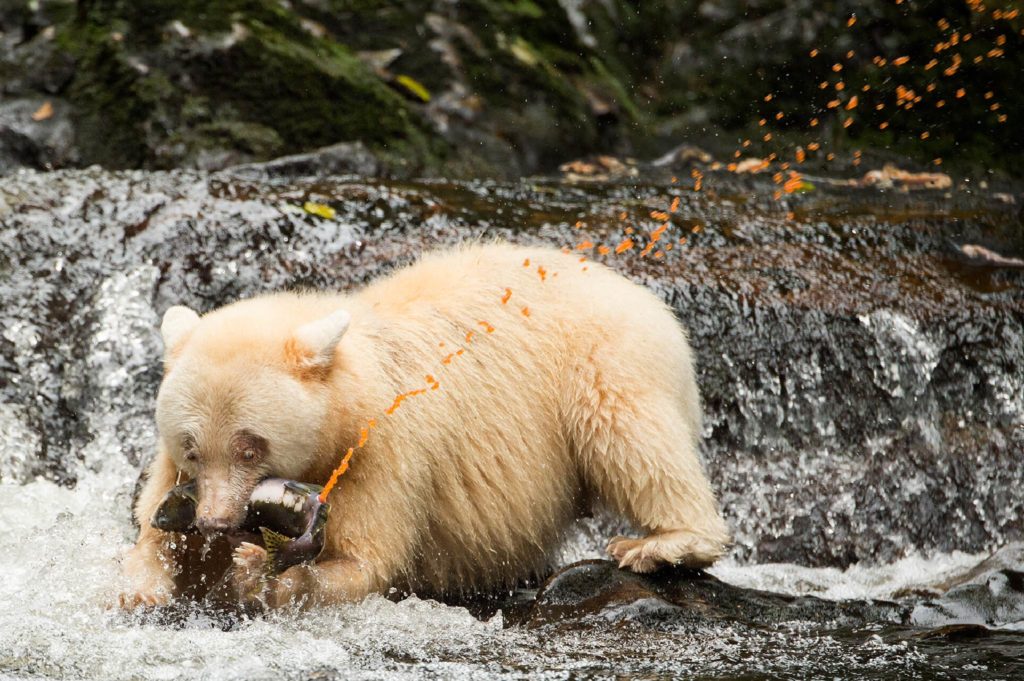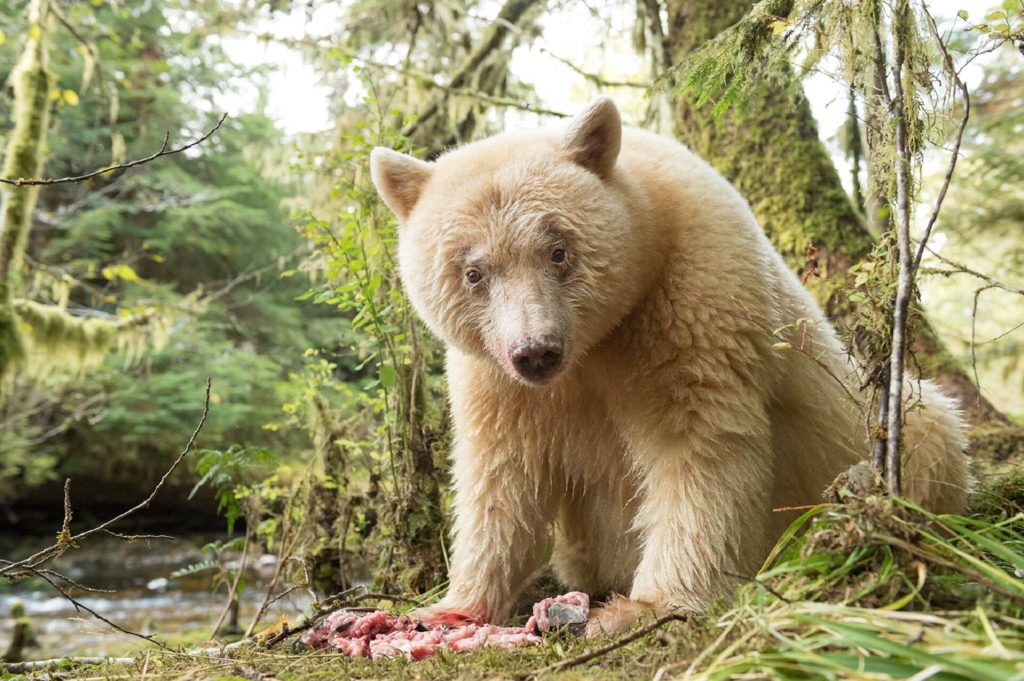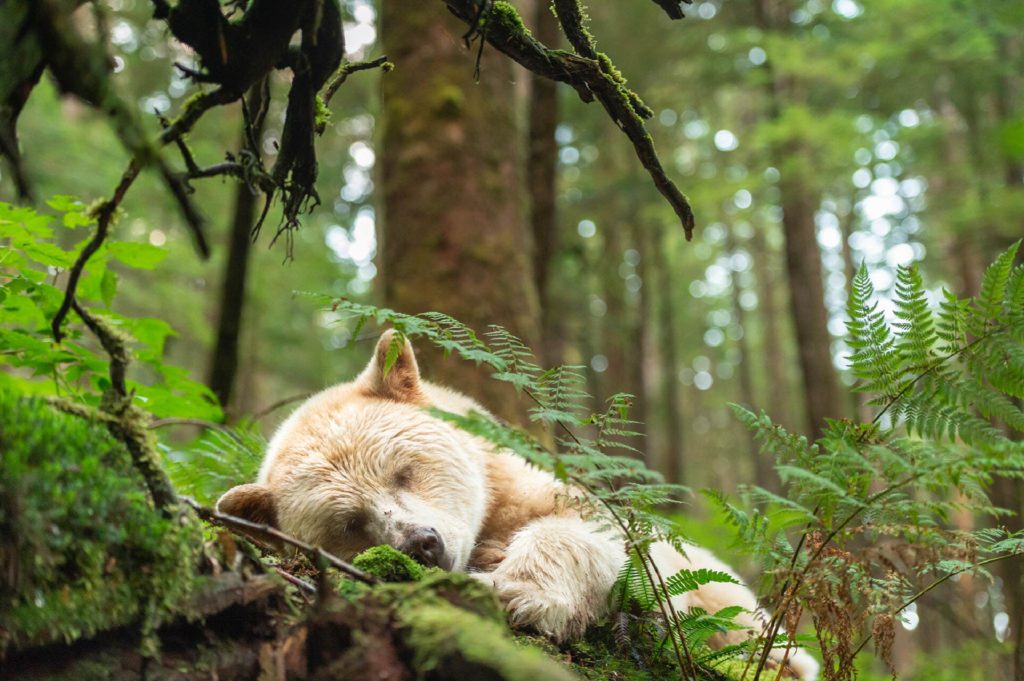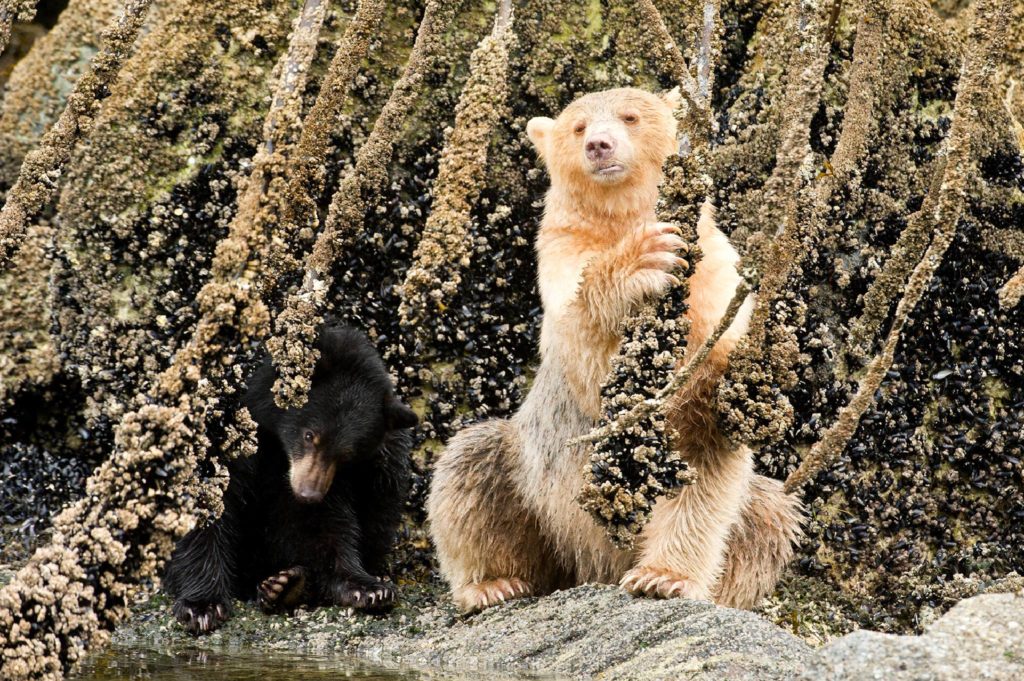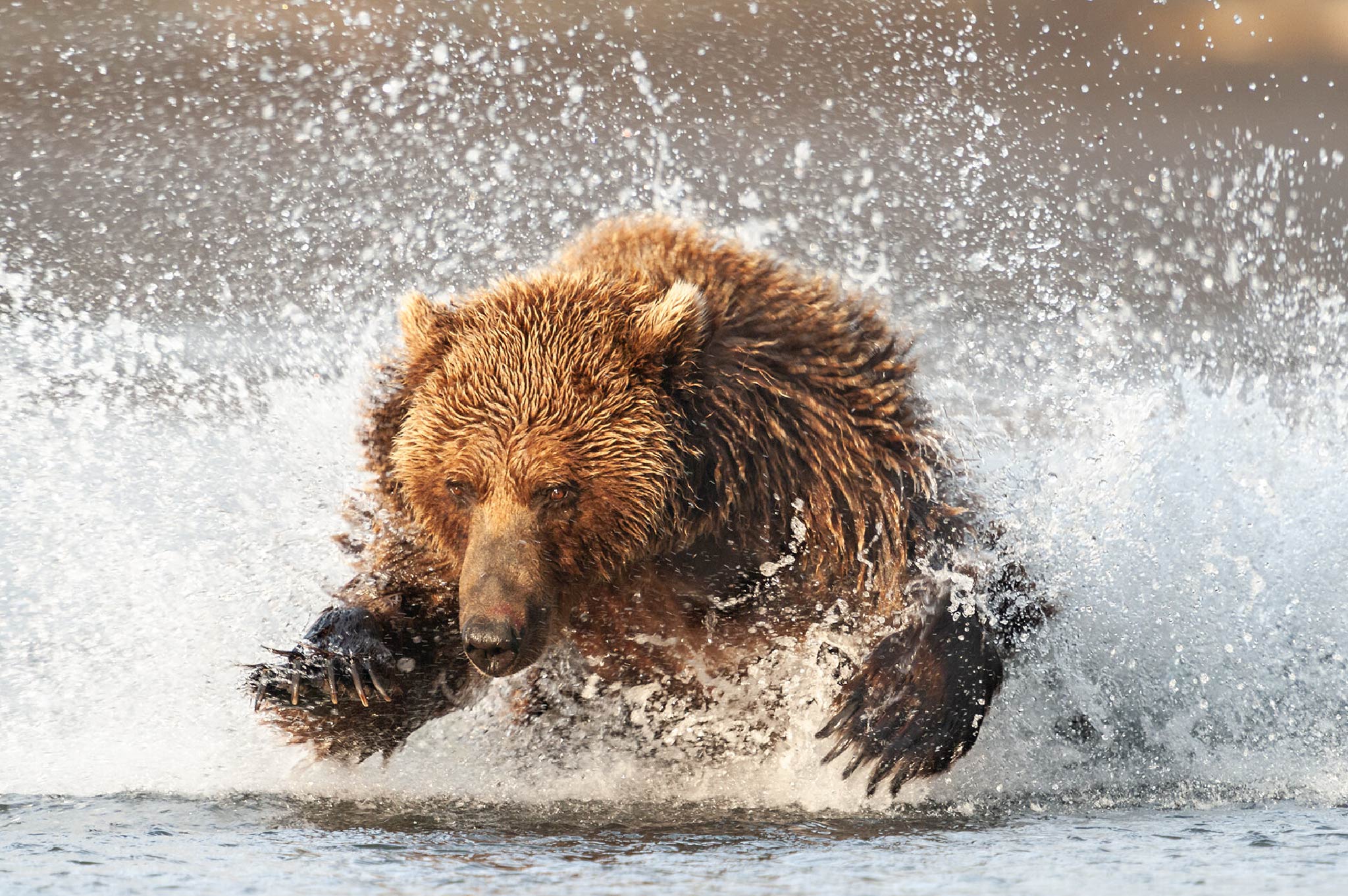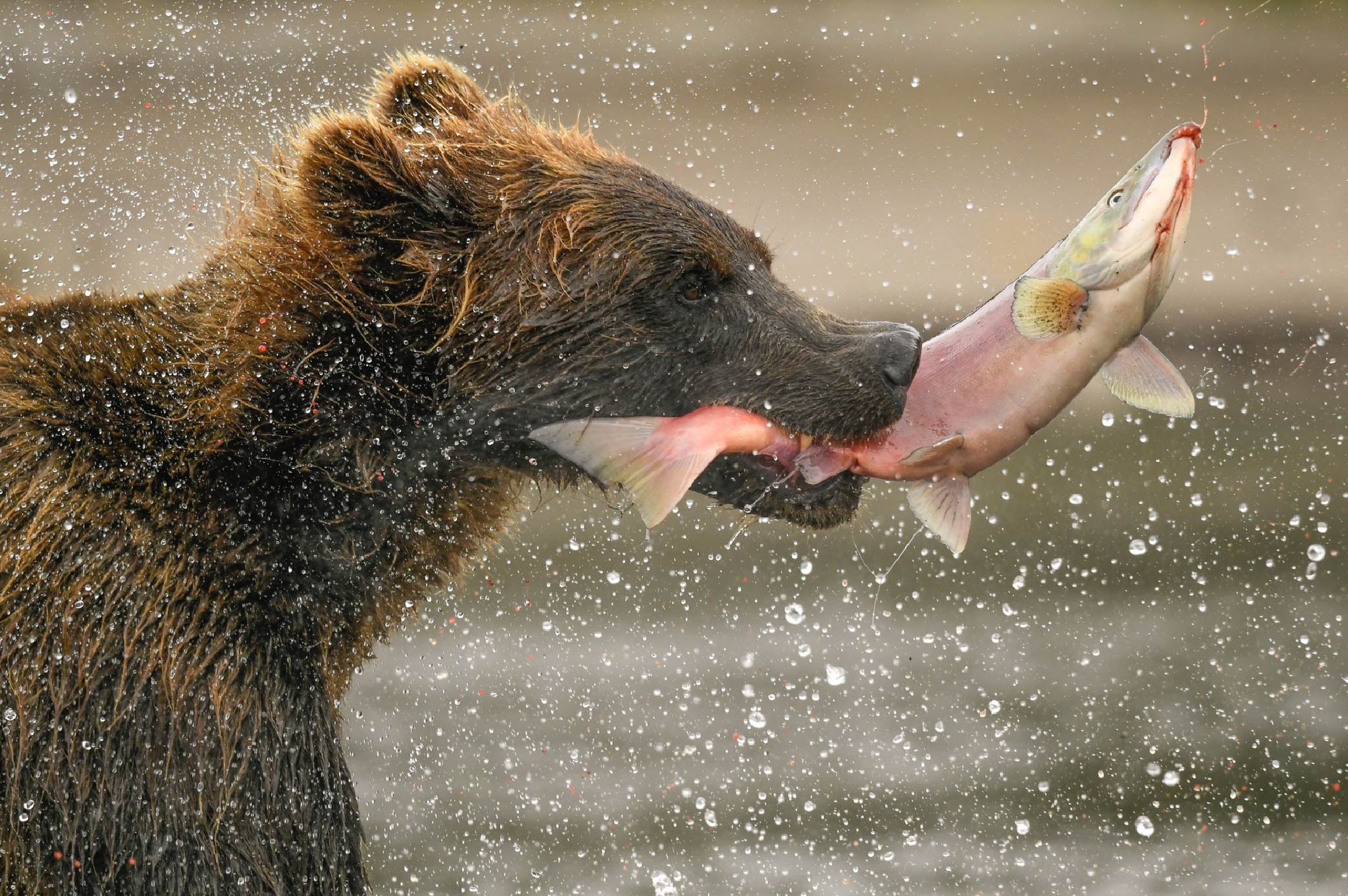When did you start photographing wildlife in the Pacific Northwest?
One of my very first international trips outside Switzerland was in 1992, to British Columbia. At the time, I was an accountant with a passion for wildlife and photography. I immediately fell in love with Canada’s West Coast, but it wasn’t until almost 20 years later that I seriously started to photograph this area. In 2011, I married Canadian artist David McEown, and since then I’ve been privileged to call Vancouver home. When living in Switzerland I always wanted to come to B.C. to photograph the elusive spirit bear, but I never had the opportunity and/or the finances for such a risky trip. When I moved to Canada in 2011, I resolved to photograph the Kermode Spirit Bear in B.C.’s Great Bear Rainforest as soon as I could. I loved it so much that I returned several times after that.
Why do you think this region is unique?
The Great Bear Rainforest is the largest coastal temperate rainforest in the world, but more than that it’s one of the most pristine places I have ever visited. Spending time in the rainforest is an incredible experience. It involves all one’s senses and perceptions. The smell of trees and mosses fills your nostrils; the rain bouncing off leaves has an almost percussion-like effect on your ears. The raven’s call often announces the arrival of the spirit of the forest: the “white bear.” The Kermode — also known as “mooksgm’ol “ by First Nations people local to the area — is in fact a rare subspecies of the North American black bear. Due to a unique, recessive gene, it has white-coloured fur. The Great Bear Rainforest is a unique ecosystem where everything is interdependent, and it needs protection. Salmon, with their cyclical spawning seasons, are the natural link that connects the forest to the ocean. Bears catch fish and then drag it into the forest to eat. Other mammals and birds feed on the remains. Nutrients in fish remains, together with the bear’s droppings, fertilize the forest soil. As conservation photographers, I’ve always felt it’s our duty to capture the beauty of places and the endangered creatures that live there. By doing so, we hope to raise awareness through the universal, emotive power of photographic images.
What are the most important conservation issues in British Columbia in your opinion?
One of the reasons I started photographing the Great Bear Rainforest was to raise awareness of the Enbridge Pipeline project, as many other great environmental organizations were doing at the same time. This multi-year effort led to a full feature article on the issue published by BBC Wildlife Magazine in 2015. Despite B.C.’s motto “Beautiful B.C.” and more than 600 regional parks around the province — giving the illusion of an untouched wilderness paradise — conservation issues are wide and varied, and they’re everywhere, from much-needed protection of the old growth-forests from logging to the need to shore up fishery regulations on wild salmon and herring stocks, to the pollution in our lakes and rivers, to the wider issue of climate change. A lot needs to be done.
Can you tell me about the first time you saw a spirit bear?
My first encounter with a spirit bear happened in 2011 on Princess Royal Island, on the other side of Hecate Strait from the Queen Charlotte Islands. After spending the better part of a day waiting by a running river, we finally saw some movement in the forest. I saw this mama bear with her black cub appearing like a ghost out of the forest and I’ll admit, I had a lump in my throat. It was akin to a mystical experience for me. I was super excited. They were moving fast, as if on a mission, and it was challenging to keep up with them on foot. So we decided to jump aboard a boat instead and follow them along the bank. It was low tide and we soon found out what they were after. When the tide is low, barnacles and mussels become exposed on rocks and dead trees. That’s the bears’ favourite snack! Like bar nuts are for us during happy hour.
How has your relationship to bears evolved over time?
As a kid, I grew up with a collection of teddy bears. I was raised in Switzerland, at a time when there were no bears to be found anywhere. I never questioned why I loved bears so much, it just seemed the natural thing to do. Over the past 15 years, I’ve focused my photographic work on the three species of North American bears. Studying the origins of human relationships with these animals led me to understand the deep bonds between us, and the problems that come with that. It’s a story of admiration and fear, worship and hunting, a relationship forged in early human times that will probably always be with us.
What are your thoughts about the current landscape for bear conservation in the province?
The B.C. Conservation Officer Service? The 2017 ban on grizzly trophy hunting in the province was a good start but a lot more needs to be done. From a strictly economic point of view, we need to convince local, regional and provincial governments — and hunting outfitters — that a live bear is worth more than a dead bear. Studies around the world have shown that ecotourism not only enhances conservation management but helps sustain local community resources, and on a wider, more equitable scale than focusing all the revenue on a handful of select hunter’s outfitters.
Why do you feel bears need our respect and protection? What role do salmon play in BC’s coastal ecosystems? Why are salmon important to the West Coast?
Bears (black, Kermode and grizzly) are paramount species in B.C. They play an important role in First Nations culture and are an important source of income for local stakeholders in terms of tourism and recreational activities. Bears help maintain a healthy ecosystem by scavenging carcasses. They help keep herbivore populations such as deer and moose in balance. Bears bridge the ecological gap between ocean and forest. By catching fish and dragging salmon carcasses into the forest to eat, bears help fertilize the soil and enrich it with nitrogen. A healthy forest nurtures the ground, helps tree roots grow and provides shade for streams. Cool streams encourage the fish to return and reproduce each year. In the circle of life, everything is interconnected. If only one element of this equation fails, the whole ecosystem fails. Salmon are the core of this delicate balance.
Can you tell me more about photographing bears hunting for salmon?
It is great fun and often exciting to photograph bears when they’re fishing. Contrary to what most people think, bears are not great “fishers.” They are successful just 25% of the time. The less experienced the bear, the better for the photographer! Inexperience means more jumping and running around, splashing in the water. Bears have different fishing styles, depending on the location and the techniques learned from their mothers.
- Sit and wait: The bears sit in a pool full of fish,and wait for the fish to come to them. The bears then pin the fish down with their paws.
- Snorkeling: The bears snorkel in a pool or lake full of fish, hoping to find the fish using their underwater eyesight. They use this technique more often toward the end of the season, when dead fish lie on the bottom of the lakebed.
- Pirating: The bears steal fish from another bear. This is why, when a young bear catches a fish, it usually runs away from the river to eat it as quickly as they can. It’s trying to avoid other, bigger bears that might steal its meal.
- Diving: In lakes and deep pools, bears will occasionally dive below the water’s surface to catch fish. They use this technique most often in the fall, when dead fish are lying on the bottom of pools and lakes.
- Dash and grab: Bears chase fish and jump on them, and use their paws to pin the fish down. This is the most photogenic hunting technique, especially if practiced by inexperienced bears. A lot of water splashing around!
What are your thoughts around human-wildlife conflicts?
Bears specifically. Rural B.C. has a reputation for being “bear country,” due to the abundance of both black and grizzly bears throughout the province, both in terms of their numbers and their distribution. The biggest threat to the bears’ survival is habitat loss, which often leads to fragmented territories. Human-wildlife conflict is perhaps inevitable, which almost always results in the eradication or problem bears. And then there’s the issue of trophy hunting. A recent study by a BC-based research team, published in Proceedings of the National Academy of Sciences (PNAS) in the summer of 2020, found that bears are changing their behavior, so they can survive in more populated areas. Clayton T. Lamb, co-author of the study, said bears living in “coexistence landscapes” — areas where they live in proximity to people — are increasing their nocturnal activity on average by two to three percent every year. This lessens the chances of being disturbed by humans, and lessens the chances for conflict as a result. While bears can adapt by changing their habits, we humans need more knowledge-based learning around bears (the “Bear Smart” community programs, to cite just one example). We need to learn ways to coexist with these amazing creatures, and we need to preserve more habitat for them to roam without the constant potential for conflict. Bears are one of the slowest reproducing land mammals. Ineffective bear management, whether by accident or design, could have dramatic consequences on their numbers.
What projects are you looking forward to working on in 2022?
I hope to continue documenting changes in the polar regions, and add to my growing body of work. I have a number of expeditions planned and assignments to fulfill, at the North Pole, off Svalbard in Norway, and of course, Antarctica.
Do you have anything else you’d like to add regarding Pacific Wild’s campaigns? Final thoughts to share with our audience?
The digital age, coupled with social media, has opened the door wider for wildlife and conservation photographers, as well as scientists, to a degree we could only imagine just 10-15 years ago. Technology and Internet platforms enable us to reach more people in more places, faster, more efficiently and more effectively than at any time in human history. We’re living in the information age. And while problems such as climate change, pollution and environmental decline are ever growing, we’ve never been in a better position, it seems to me, to convey a message of hope and renewal.
Follow Daisy’s work on Instagram @daisygilardini

